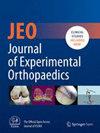This study aimed to evaluate the effectiveness of an original mechanical testing setup including the humerus, myotendinous junction and scapula designed to assess the structural properties of rotator cuff attachments in large animals and determine optimal conditions.
Eight domestic pigs (age, 4–6 months; weight, 30–52 kg) without genetic modifications were euthanized under intubated general anaesthesia control. The scapula–supraspinatus tendon complex with the humerus was excised as a single unit. A device was developed on a universal testing machine to pull in the direction of the tendon's path. After preconditioning at 5 N for 30 s, the composite was stretched to failure at 50 mm/min, and the failure mode was observed. The normality of each structural property was evaluated using the Shapiro–Wilk test. Student's t test or the Mann–Whitney U-test was used to compare whether the structural properties vary in failure modes.
Nine shoulders (56%) ruptured at the humeral attachment; in the remaining seven, the tendon was pulled out from the scapula, leading to rupture. The maximum load and elongation at failure showed normality, whereas the yield load and linear stiffness did not show normality. The mean (standard deviation) maximum load and elongation at failure were 346.4 (99.2) N and 43.1 (12.2) mm, respectively. The median (first and third quartiles) yield load and linear stiffness were 81.2 (63.0, 121.6) N and 15.8 (14.8, 17.5) N/mm, respectively.
This mechanical testing system is useful for evaluating the structural properties of porcine rotator cuff attachments and should be additionally evaluated by cyclic testing.
Level IV.



